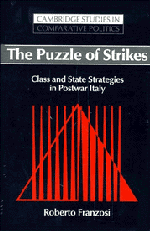Book contents
- Frontmatter
- Contents
- List of tables, figures, and equations
- Dedication
- Preface
- Acknowledgments
- 1 The puzzle box
- 2 Labor-market conditions and bargaining power
- 3 When do workers strike? How the economy matters
- 4 Organizational resources and collective action
- 5 The structure of collective bargaining
- 6 Class power, politics, and conflict
- 7 Mobilization processes: the 1969 autunno caldo
- 8 Countermobilization processes: reactions by the state and employers to strike waves
- 9 The picture in the puzzle
- Epilogue
- Appendix: the data
- Notes
- Bibliography
- Index
6 - Class power, politics, and conflict
Published online by Cambridge University Press: 08 January 2010
- Frontmatter
- Contents
- List of tables, figures, and equations
- Dedication
- Preface
- Acknowledgments
- 1 The puzzle box
- 2 Labor-market conditions and bargaining power
- 3 When do workers strike? How the economy matters
- 4 Organizational resources and collective action
- 5 The structure of collective bargaining
- 6 Class power, politics, and conflict
- 7 Mobilization processes: the 1969 autunno caldo
- 8 Countermobilization processes: reactions by the state and employers to strike waves
- 9 The picture in the puzzle
- Epilogue
- Appendix: the data
- Notes
- Bibliography
- Index
Summary
The business cycle is the cause of the main fluctuations, indeed of the very nature of strikes themselves; by itself, however, it cannot explain the depth of certain retreats, the amplitude of certain offensives. Political circumstances weigh very heavily and provide the key to the understanding of the major silences and thrusts.
Perrot(1974, p. 722)Politics constitutes an important kind of precondition for the eruption of large-scale worker movements, though not being in itself a sufficient one.
Shorter and Tilly (1974, p. 104)The apolitical nature [of trade unions] is a lie, because it cannot exist. Trade unions must have a political outlook … to protect the interests of all workers of any political party or even without a party. To accomplish their goals, trade unions often need the support of political parties. Trade unions have often turned to popular and democratic parties and to their parliamentary groups, in order to lobby for the approval or rejection of a given law, in the workers' best interests.
Di Vittorio (quoted in CESOS-CISL and IRES-CGIL, 1984, p. 303)LEFT TO EXPLAIN: THE 1975–78 STRIKE SHAPES
Little by little, chapter by chapter, I have used the available theories about strikes to investigate the meaning of the data presented in Chapter 1 (the pieces of the puzzle). I have fitted almost the entire puzzle. I am left with only one of the original pieces (the 1975–78 strike shapes) and one theory: political exchange. But in fact, do we not already have an explanation for the 1975–78 strike shapes? Did we not see, in Chapter 5, that the 1975 wage escalator agreement between labor and capital could account for the lower frequency,
- Type
- Chapter
- Information
- The Puzzle of StrikesClass and State Strategies in Postwar Italy, pp. 190 - 256Publisher: Cambridge University PressPrint publication year: 1995

